Recombinant sindbis/Venezuelan equine encephalitis virus is highly attenuated and immunogenic
- PMID: 12915543
- PMCID: PMC187387
- DOI: 10.1128/jvi.77.17.9278-9286.2003
Recombinant sindbis/Venezuelan equine encephalitis virus is highly attenuated and immunogenic
Abstract
Venezuelan equine encephalitis virus (VEEV) is an important, naturally emerging zoonotic virus. VEEV was a significant human and equine pathogen for much of the past century, and recent outbreaks in Venezuela and Colombia (1995), with about 100,000 human cases, indicate that this virus still poses a serious public health threat. The live attenuated TC-83 vaccine strain of VEEV was developed in the 1960s using a traditional approach of serial passaging in tissue culture of the virulent Trinidad donkey (TrD) strain. This vaccine presents several problems, including adverse, sometimes severe reactions in many human vaccinees. The TC-83 strain also retains residual murine virulence and is lethal for suckling mice after intracerebral (i.c.) or subcutaneous (s.c.) inoculation. To overcome these negative effects, we developed a recombinant, chimeric Sindbis/VEE virus (SIN-83) that is more highly attenuated. The genome of this virus encoded the replicative enzymes and the cis-acting RNA elements derived from Sindbis virus (SINV), one of the least human-pathogenic alphaviruses. The structural proteins were derived from VEEV TC-83. The SIN-83 virus, which contained an additional adaptive mutation in the nsP2 gene, replicated efficiently in common cell lines and did not cause detectable disease in adult or suckling mice after either i.c. or s.c. inoculation. However, SIN-83-vaccinated mice were efficiently protected against challenge with pathogenic strains of VEEV. Our findings suggest that the use of the SINV genome as a vector for expression of structural proteins derived from more pathogenic, encephalitic alphaviruses is a promising strategy for alphavirus vaccine development.
Figures

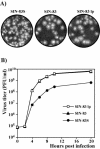
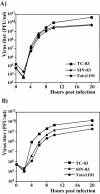
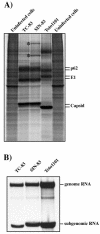
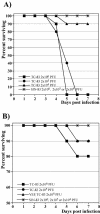
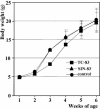
Similar articles
-
Current Understanding of the Molecular Basis of Venezuelan Equine Encephalitis Virus Pathogenesis and Vaccine Development.Viruses. 2019 Feb 18;11(2):164. doi: 10.3390/v11020164. Viruses. 2019. PMID: 30781656 Free PMC article. Review.
-
Replication and clearance of Venezuelan equine encephalitis virus from the brains of animals vaccinated with chimeric SIN/VEE viruses.J Virol. 2006 Mar;80(6):2784-96. doi: 10.1128/JVI.80.6.2784-2796.2006. J Virol. 2006. PMID: 16501087 Free PMC article.
-
Venezuelan equine encephalitis virus variants lacking transcription inhibitory functions demonstrate highly attenuated phenotype.J Virol. 2015 Jan;89(1):71-82. doi: 10.1128/JVI.02252-14. Epub 2014 Oct 15. J Virol. 2015. PMID: 25320296 Free PMC article.
-
IRES-driven expression of the capsid protein of the Venezuelan equine encephalitis virus TC-83 vaccine strain increases its attenuation and safety.PLoS Negl Trop Dis. 2013 May 9;7(5):e2197. doi: 10.1371/journal.pntd.0002197. Print 2013. PLoS Negl Trop Dis. 2013. PMID: 23675542 Free PMC article.
-
A roadmap for developing Venezuelan equine encephalitis virus (VEEV) vaccines: Lessons from the past, strategies for the future.Int J Biol Macromol. 2023 Aug 1;245:125514. doi: 10.1016/j.ijbiomac.2023.125514. Epub 2023 Jun 21. Int J Biol Macromol. 2023. PMID: 37353130 Review.
Cited by
-
Current Understanding of the Molecular Basis of Venezuelan Equine Encephalitis Virus Pathogenesis and Vaccine Development.Viruses. 2019 Feb 18;11(2):164. doi: 10.3390/v11020164. Viruses. 2019. PMID: 30781656 Free PMC article. Review.
-
Entry receptor LDLRAD3 is required for Venezuelan equine encephalitis virus peripheral infection and neurotropism leading to pathogenesis in mice.Cell Rep. 2023 Aug 29;42(8):112946. doi: 10.1016/j.celrep.2023.112946. Epub 2023 Aug 8. Cell Rep. 2023. PMID: 37556325 Free PMC article.
-
Alphavirus production is inhibited in neurofibromin 1-deficient cells through activated RAS signalling.Virology. 2008 Jul 20;377(1):133-42. doi: 10.1016/j.virol.2008.03.025. Epub 2008 May 15. Virology. 2008. PMID: 18485440 Free PMC article.
-
Alpha-beta T cells provide protection against lethal encephalitis in the murine model of VEEV infection.Virology. 2007 Oct 25;367(2):307-23. doi: 10.1016/j.virol.2007.05.041. Epub 2007 Jul 5. Virology. 2007. PMID: 17610927 Free PMC article.
-
VIPR HMM: a hidden Markov model for detecting recombination with microbial detection microarrays.Bioinformatics. 2012 Nov 15;28(22):2922-9. doi: 10.1093/bioinformatics/bts560. Epub 2012 Oct 7. Bioinformatics. 2012. PMID: 23044542 Free PMC article.
References
-
- Alevizatos, A. C., R. W. McKinney, and R. D. Feigin. 1967. Live, attenuated Venezuelan equine encephalomyelitis virus vaccine. I. Clinical effects in man. Am. J. Trop. Med. Hyg. 16:762-768. - PubMed
-
- Berge, T. O., I. S. Banks, and W. D. Tigertt. 1961. Attenuation of Venezuelan equine encephalomyelitis virus by in vitro cultivation in guinea pig heart cells. Am. J. Hyg. 73:209-218.
-
- Burke, D. S., H. H. Ramsburg, and R. Edelman. 1977. Persistence in humans of antibody to subtypes of Venezuelan equine encephalomyelitis (VEE) virus after immunization with attenuated (TC-83) VEE virus vaccine. J. Infect. Dis. 136:354-359. - PubMed
Publication types
MeSH terms
Substances
Grants and funding
LinkOut - more resources
Full Text Sources
Other Literature Sources
Miscellaneous

